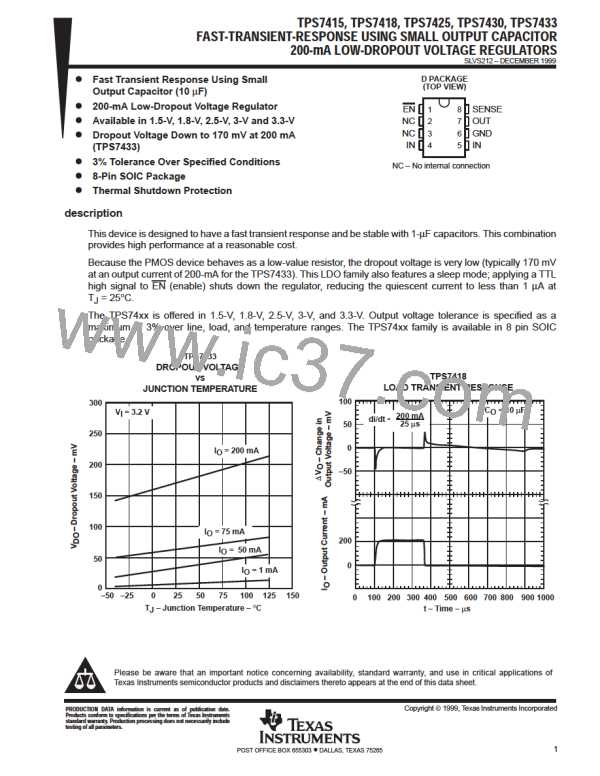TPS7415, TPS7418, TPS7425, TPS7430, TPS7433
FAST-TRANSIENT-RESPONSE USING SMALL OUTPUT CAPACITOR
200-mA LOW-DROPOUT VOLTAGE REGULATORS
SLVS212 – DECEMBER 1999
APPLICATION INFORMATION
regulator protection (continued)
The TPS74xx also features internal current limiting and thermal protection. During normal operation, the
TPS74xx limits output current to approximately 500 mA. When current limiting engages, the output voltage
scales back linearly until the overcurrent condition ends. While current limiting is designed to prevent gross
device failure, care should be taken not to exceed the power dissipation ratings of the package. If the
temperature of the device exceeds 150°C(typ), thermal-protection circuitry shuts it down. Once the device has
cooled below 130°C (typ), regulator operation resumes.
power dissipation and junction temperature
Specified regulator operation is assured to a junction temperature of 125°C; the maximum junction temperature
should be restricted to 125°C under normal operating conditions. This restriction limits the power dissipation
the regulator can handle in any given application. To ensure the junction temperature is within acceptable limits,
calculate the maximum allowable dissipation, P
, and the actual dissipation, P , which must be less than
D(max)
D
or equal to P
.
D(max)
The maximum-power-dissipation limit is determined using the following equation:
T max
J
T
A
P
D(max)
R
JA
Where
T max is the maximum allowable junction temperature.
J
R
SOIC.
is the thermal resistance junction-to-ambient for the package, i.e., 172°C/W for the 8-terminal
θJA
T is the ambient temperature.
A
The regulator dissipation is calculated using:
P
V
V
I
D
I
O
O
Power dissipation resulting from quiescent current is negligible. Excessive power dissipation will trigger the
thermal protection circuit.
12
POST OFFICE BOX 655303 • DALLAS, TEXAS 75265

 TI [ TEXAS INSTRUMENTS ]
TI [ TEXAS INSTRUMENTS ]